Starting the Trace
Prev
Next
|
Day 4: December 26, 2006 Starting the Trace |
Prev Next |
|
|
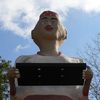

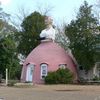 I knew this place, a half dozen miles south of Natchez, only serves lunch,
so I timed my arrival for just a few minutes after their normal opening
time. No luck. Mammy's Cupboard wasn't bare but it wasn't open either. The
good news is the blue sky visible behind Mammy's head. The day started out
in the forties and would eventually reach fifty-something. Clear &
crisp.
I knew this place, a half dozen miles south of Natchez, only serves lunch,
so I timed my arrival for just a few minutes after their normal opening
time. No luck. Mammy's Cupboard wasn't bare but it wasn't open either. The
good news is the blue sky visible behind Mammy's head. The day started out
in the forties and would eventually reach fifty-something. Clear &
crisp.
|
|
|
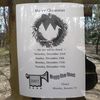
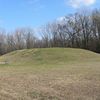
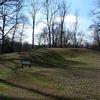
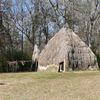 I had actually pulled through the parking lot at the
Grand Village of the Natchez Indians yesterday during
a little exploratory driveabout. I hadn't stopped since the museum was
certainly closed and it was too cold and wet to go roaming around the
mounds. Still no luck with the museum but it was a pretty good day to walk
the path and read the signs. This site was occupied when the French
started moving in around 1682. In 1716 they established Fort Rosalie where
the city of Natchez is today and the Indians soon figured out that the
Frenchmen weren't planning on leaving anytime soon. In 1729, the Natchez
massacred everyone at Fort Rosalie in a well organized attack and briefly
returned to life without Europeans. They soon became painfully aware that
the fort had held just a tiny bit of the world's supply of French. Very
few Natchez Indians survived the retaliation and they disappeared into
slavery or nearby tribes. The Natchez tribe ceased to exist.
I had actually pulled through the parking lot at the
Grand Village of the Natchez Indians yesterday during
a little exploratory driveabout. I hadn't stopped since the museum was
certainly closed and it was too cold and wet to go roaming around the
mounds. Still no luck with the museum but it was a pretty good day to walk
the path and read the signs. This site was occupied when the French
started moving in around 1682. In 1716 they established Fort Rosalie where
the city of Natchez is today and the Indians soon figured out that the
Frenchmen weren't planning on leaving anytime soon. In 1729, the Natchez
massacred everyone at Fort Rosalie in a well organized attack and briefly
returned to life without Europeans. They soon became painfully aware that
the fort had held just a tiny bit of the world's supply of French. Very
few Natchez Indians survived the retaliation and they disappeared into
slavery or nearby tribes. The Natchez tribe ceased to exist.
|
|
|
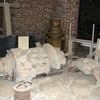
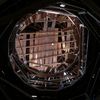
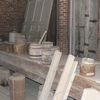
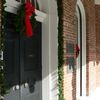
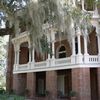
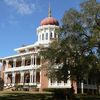 I had read that, if you can only see one Natchez mansion, make it Longwood
and a fellow I spoke with at the Under the Hill Saloon said almost exactly
the same thing. Not only did this place come highly recommended, it was
open. Construction started on the six story building in 1860 and proceeded
rapidly right up to the day workmen heard that war had broken out. The
shell was pretty much complete as was the bottom floor or basement. The
owners, Haller & Julia Nutt, moved in to wait out the war in the
basement's mere 10,000 square feet of space. The Nutts expected the war to
be over in ninety days or so. That guess was, of course, way off and
neither Mr. Nutt or the family fortune survived the four year war. Mrs.
Nutt was not destitute but there wasn't enough money left to even consider
finishing the house. She seems to have become rather skilled at putting
off her creditors and among the debts that were never settled was Samuel
Sloan's $5,000 fee for designing the house. Pictures show the pocket
shutters Sloan designed to avoid the unattractive sight of open curved top
panels, some of the stuff left behind when work ceased, and a view up to
the unfinished dome. The last picture is of the twenty-four foot wooden
finial that once sat atop the dome. Woodpeckers worked it over pretty good
and, when the house was restored, it was replaced by a $50,000 fiberglass
version that woodpeckers have no use for. The original cost $250 but, as
with so many things, you get what you pay for when it comes to woodpecker
proofing your finial.
I had read that, if you can only see one Natchez mansion, make it Longwood
and a fellow I spoke with at the Under the Hill Saloon said almost exactly
the same thing. Not only did this place come highly recommended, it was
open. Construction started on the six story building in 1860 and proceeded
rapidly right up to the day workmen heard that war had broken out. The
shell was pretty much complete as was the bottom floor or basement. The
owners, Haller & Julia Nutt, moved in to wait out the war in the
basement's mere 10,000 square feet of space. The Nutts expected the war to
be over in ninety days or so. That guess was, of course, way off and
neither Mr. Nutt or the family fortune survived the four year war. Mrs.
Nutt was not destitute but there wasn't enough money left to even consider
finishing the house. She seems to have become rather skilled at putting
off her creditors and among the debts that were never settled was Samuel
Sloan's $5,000 fee for designing the house. Pictures show the pocket
shutters Sloan designed to avoid the unattractive sight of open curved top
panels, some of the stuff left behind when work ceased, and a view up to
the unfinished dome. The last picture is of the twenty-four foot wooden
finial that once sat atop the dome. Woodpeckers worked it over pretty good
and, when the house was restored, it was replaced by a $50,000 fiberglass
version that woodpeckers have no use for. The original cost $250 but, as
with so many things, you get what you pay for when it comes to woodpecker
proofing your finial.
|
|
|
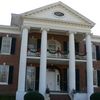
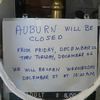 Another saloon patron recommended the Auburn house which is fairly close
to Longwood. It turned out to be another place where I was one day early.
Another saloon patron recommended the Auburn house which is fairly close
to Longwood. It turned out to be another place where I was one day early.
|
|
|
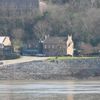
 Back at Longwood, while we waited for the tour to start, a Missouri couple
asked for lunch suggestions and I listened in. Two of the places mentioned
were in Louisiana and, since I had a short Louisiana excursion in mind, I
decided I'd give them a try. I went to Slough Daddy's first primarily
because it is on the river. It was closed but I used the parking lot to
take pictures of Under the Hill from over the river. The Sandbar was open
and, for $6.50, they supplied me with a mound of excellent catfish.
Back at Longwood, while we waited for the tour to start, a Missouri couple
asked for lunch suggestions and I listened in. Two of the places mentioned
were in Louisiana and, since I had a short Louisiana excursion in mind, I
decided I'd give them a try. I went to Slough Daddy's first primarily
because it is on the river. It was closed but I used the parking lot to
take pictures of Under the Hill from over the river. The Sandbar was open
and, for $6.50, they supplied me with a mound of excellent catfish.
|
|
|
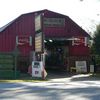
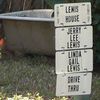 This is the real reason for my river crossing but it was sort of closed,
too. Connected to the drive-through is the home of Jerry Lee Lewis'
sister, Frankie. The house is reportedly filled with memorabilia and
visitors are normally welcomed for a donation. But not today. I spoke with
Frankie's husband who explained that his wife had gone to Tennessee to
visit relatives for Christmas. I should have asked, but didn't, whether it
was to Jerry Lee's place near Memphis. Since he was the only one there and
had to tend to the drive-through, there could be no tour. In hindsight, I
wish I had begged for a peek inside but I'm determined to get back
someday.
This is the real reason for my river crossing but it was sort of closed,
too. Connected to the drive-through is the home of Jerry Lee Lewis'
sister, Frankie. The house is reportedly filled with memorabilia and
visitors are normally welcomed for a donation. But not today. I spoke with
Frankie's husband who explained that his wife had gone to Tennessee to
visit relatives for Christmas. I should have asked, but didn't, whether it
was to Jerry Lee's place near Memphis. Since he was the only one there and
had to tend to the drive-through, there could be no tour. In hindsight, I
wish I had begged for a peek inside but I'm determined to get back
someday.
|
|
|
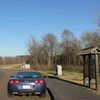
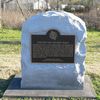
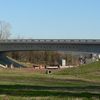
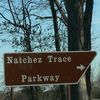 Now here's the point of the whole trip or at least the thing it grew
around. The Natchez
Trace Parkway starts just a couple of miles from the river near where
US-61 crosses Liberty Road. From Liberty, an entrance ramp curves around
to cross the pictured overpass and the Parkway begins. Almost immediately,
there is a convenient pullover next to the DAR marker and a panel
providing a quick overview of the Trace and its history.
Now here's the point of the whole trip or at least the thing it grew
around. The Natchez
Trace Parkway starts just a couple of miles from the river near where
US-61 crosses Liberty Road. From Liberty, an entrance ramp curves around
to cross the pictured overpass and the Parkway begins. Almost immediately,
there is a convenient pullover next to the DAR marker and a panel
providing a quick overview of the Trace and its history.
|
|
|
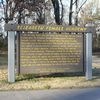
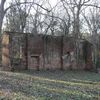 That wall has been standing a long time but is all that is left of the
Elizabeth Female Academy. The academy operated between 1818 and 1845.
That wall has been standing a long time but is all that is left of the
Elizabeth Female Academy. The academy operated between 1818 and 1845.
|
|
|
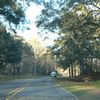 An Airstream heading up the Parkway is a great photo op and I wish I could
have done better than this through the windshield shot. I saw this same
Airstream in the parking lot of the Grand Village of the Natchez Indians
when I returned to my car.
An Airstream heading up the Parkway is a great photo op and I wish I could
have done better than this through the windshield shot. I saw this same
Airstream in the parking lot of the Grand Village of the Natchez Indians
when I returned to my car.
|
|
|
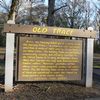
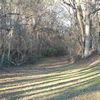 This is the first place where the "sunken trace" can be seen.
Many years of passing feet and hoofs have worn away several feet of the
soft soil.
This is the first place where the "sunken trace" can be seen.
Many years of passing feet and hoofs have worn away several feet of the
soft soil.
|
|
|
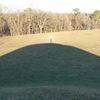
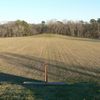
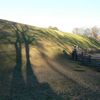
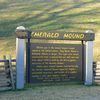 They say this is smaller than Cahokia's Monk's Mound but it's kind of hard
to tell. They are both huge.
Emerald Mound was built and abandoned by the Natchez
before the mounds at Grand Village. Two round mounds set atop the large
flat mound and fifty-one steps lead to the top of the largest. The sun was
getting low and the mound casts a really big shadow with me on top. It
makes me look quite thin and that's pretty cool.
They say this is smaller than Cahokia's Monk's Mound but it's kind of hard
to tell. They are both huge.
Emerald Mound was built and abandoned by the Natchez
before the mounds at Grand Village. Two round mounds set atop the large
flat mound and fifty-one steps lead to the top of the largest. The sun was
getting low and the mound casts a really big shadow with me on top. It
makes me look quite thin and that's pretty cool.
|
|
|
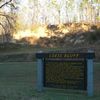
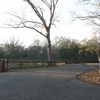 Not long after I stopped at Loess Bluff and pulled up to the closed gate
at Mount Locust, the sun was gone. I headed into Port Gibson with
intentions of spending the night there. I had read of at least one motel
in town and one not-in-the-budget B&B. The motel was closed and I saw
no evidence of others. The GPS showed lots of motels in Vicksburg which I
was surprised to see was less than twenty-five miles away. Looks like I'll
get to walk some of that battlefield after all.
Not long after I stopped at Loess Bluff and pulled up to the closed gate
at Mount Locust, the sun was gone. I headed into Port Gibson with
intentions of spending the night there. I had read of at least one motel
in town and one not-in-the-budget B&B. The motel was closed and I saw
no evidence of others. The GPS showed lots of motels in Vicksburg which I
was surprised to see was less than twenty-five miles away. Looks like I'll
get to walk some of that battlefield after all.
|
|
|
| [Prev] [Site Home] [Home] [Contact] [Next] |